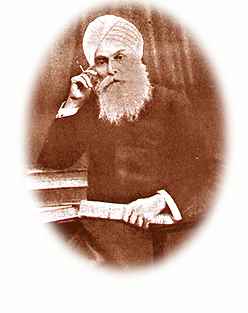The Many Splendoured -
Bhai Kahn Singh Nabha

Courtesy Sikh Review:
Mrs. Haridarshan Kaur Singh
Best known for his Mahankosh, the first Encyclopedia of Sikhism in Punjabi, the legendary Bhai Kahn Singh This tribute to the legendary scholar and social reformer comes from his grand daughter (and wife of Sikh Review editorial panelist Rear Admiral Satyindra Singh, AVSM). Bhai Kahn Singh's personal library, including his exclusive collection of rare manuscripts, has been donated to the University by his son, the pate Sr. Bhagwant Singh Hari, who was, in his own right, a perceptive researcher known for three notable works in Punjabi: Ram-Neeti, Vidhi-Nikhed, Tuk-Tatkara Dasam Granth and Bani-Beora Dasam Granth.
As I pick up my pen to write about Bhai Sahib Kahn Singh of Nabha, I have to overcome my inadequacy. I knew him so well; yet perhaps only superficially in.so far as his literary achievements are concerned. Being born as his grand daughter privileged me to be very close to this genius. He passed into history sixty years ago on 23 November, 1938.
Bhai Kahn Singh was a revolutionary Gursikh far ahead of his times, as I so fre-quently experienced and perceive even today. Always immaculately dressed to suit the oc-casion, a very integrated personality, he spoke softly in a well-measured tone and invariably gave full consideration and respect to the views of others.
He was born in 1861 in village Sabaz Banera about 5 miles from Nabha, in his maternal grandparents' house. His father, Baba Narayan Singh was from a family of farmers. His great grandfather, Baba Naudh Singh was Chaudhri of village Pitho, near Rampura Phul, and earlier had also served Maharaja Ranjit Singh. Baba Naudh Singh's, son Baba Sarup Singh (who was Bhai Kahn Singh's grandfa-ther) was a deeply religious person, who, because of his renown, was invited by Raja Jaswant Singh of Nabha to come and live in Nabha. Raja Jaswant Singh was a great devo-tee of Baba Ajaipal Singh who lived in a secluded place in Nabha. Baba Sarup Singh also became a devotee of Baba Ajaipal Singh; so close was he that the latter entrusted the Gurdwara in Nabha to him on his death in 1813. When he passed away in 1861, the duties and service of the Gurdwara devolved on Baba Narayan Singh, Bhai Kahn Singh's father.
Baba Narayan Singh was a saintly person who regularly recited the whole Guru Granth Sahib four times in a month. Thrice in his life he recited Guru Granth Sahib in one sitting (once Maharaja Hira Singh of Nabha sat with him to listen to the path recitation.) As a mark of respect, Maharaja Hira Singh, on that oc-casion, was one of Baba Narayan Singh's Palanquin bearers. Bhai Kahn Singh was five years old when his father initiated him into the recitation of Guru Granth Sahib, and at seven years of his age he could read very well. His father arranged for him to learn Hindi, Brij Bhasha and Sanskrit and the writing of po-etry from learned pandits in and around Nabha. He learnt music from Mahant Gaja Singh. When he was 20 years old, he got interested in learning Persian. People complained to Baba Narayan Singh against the son's pursuit of the Persian language and com-pelled him to drop it. Bhai Kahn Singh did not believe in this narrow mindedness and, after some time, quietly left for Delhi to learn Persian and soon after went away to Lahore to study Persian texts related to Sikh history, e.g. Zafar Nama, etc.
Bhai Kahn Singh did not attend any school or university. He was nevertheless a dedicated seeker after knowledge. His yearning for study made him lock himself up in a small room where he would burn midnight oil in his quest for knowledge. From the Gurdwara he learnt religious texts, from the Nihangs, the handling of arms, from Pandits, Sanskrit and Hindi; Urdu and Persian from Maulvis in Delhi, Lucknow and Lahore. While in Lahore, he started being interested in Shri Guru Singh Sabha and assisted Professor Gurmukh Singh of the Oriental College in the monthly and weekly magazines and newspapers. After two years in Lahore, he returned to Nabha.
Bhai Kahn Singh had by now become renowned for his knowledge, statesmanship, sound judgement and clarity of thought. He entered Nabha State Service under Maharaja Hira Singh, variously as tutor to Maharaja's son, judge, administrator and foreign minister. Since the Maharaja acknowledged his versatility and knowledge he sent him to England thrice to represent the legal aspects of the Nabha State case in 1907, 1908 and 1909. Being in State Service he could not devote time to his studies and Panthic service, so he resigned.
Bhai Kahn Singh first met Mr. M. A. McAuliffe in Rawalpindi where he had gone with the Maharaja. McAuliffe got permission from the Maharaja to allow Bhai Kahn Singh to teach him about the Sikh religion. He stayed back there for three months. Subsequently, McAuliffe spent many winters in Nabha and summers in the Hill Stations with Bhai Kahn Singh to study Sikh religion and Sikh history and, of course, Gurmukhi. McAuliffe's Book, 'The Sikh Religion' was published by the Oxford University Press in 1907 in London. Bhai Kahn Singh's contribution was acknowledged and McAuliffe had transferred the copyright of the book in Bhai Kahn Singh's name. He had also offered one of his houses in England to him, an offer, which was declined. As a result of his studies and research he wrote many books. Amongst these were : Raj Dharam - his first writing at the age of 23 prompted by Maharaja Hira Singh of Nabha. Natak Bhawanath Deepika Teeka for which he had collected notes while teaching Tikka Ripudaman Singh.